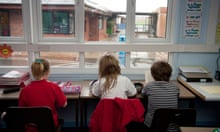The government is being urged to tackle segregation in schools after research claimed that more than a quarter of all state primary schools across England and four in 10 state secondaries were ethnically segregated.
The study, which uses a new measure of segregation, also claims that 30% of primary schools and 28% of secondaries are split by socio-economic background.
It says there were “significant falls” in the percentage of white British children attending local schools between 2011 and 2016 in some areas, with primaries becoming more ethnically segregated in the past five years in more than half of the 150 areas analysed.
Segregation levels have fallen in schools in Bradford in West Yorkshire and Oldham in Lancashire, but the report says the problem is increasing in Blackburn in Lancashire, Kirklees in West Yorkshire, the London borough of Barnet and Peterborough in Cambridgeshire.
The research, Understanding school segregation in England: 2011 to 2016, was published on Wednesday by the social integration charity The Challenge, the Institute of Community Cohesion (iCoCo) and the education data analysis company SchoolDash.
Prof Ted Cantle, iCoCo’s founder, said the findings were deeply worrying and that bridges were being slowly dismantled between communities.
The race equality thinktank the Runnymede Trust, however, expressed reservations about the methodology used to measure segregation and said the findings may have been unnecessarily alarmist.
The study, which is based on analysis of Department for Education data for more than 20,000 state schools, defines an institution as segregated if the proportion of minority ethnic pupils or pupils on free school meals is very different to those at neighbouring schools.
Omar Khan, the Runnymede Trust’s director, said: “We agree there are concerns about integration in schools. However we are unfamiliar with this indicator and there’s a real danger that this is an exaggeration of the extent to which schools are ethnically segregated.
“All the best measures that we have on segregation show that segregation is decreasing in Britain. White British people and ethnic minorities are much more likely to live near and know people of other backgrounds than they have been at any time in our nation’s history.”
Among the findings, the report says primary faith schools are more ethnically segregated than non-faith schools, at 29% as opposed to 25%, when compared with neighbouring schools.
Primary schools with a religious character are also more likely to have a wealthier student population, with 27% having significantly fewer disadvantaged pupils than other nearby schools, compared with 17% of non-faith primaries.
Secondary schools judged inadequate by the watchdog Ofsted tended to be more ethnically segregated, according to the report’s calculations, while outstanding schools were more likely to have a representative mix of pupils. Grammar schools were severely segregated by social background.
Cantle said: “We know that contact between groups improves tolerance and breaks down prejudice – and will even contribute to tackling extremism. But we appear to be going in the opposite direction.
“We cannot do very much about residential segregation – people cannot be moved from one area to another. So schools are our best chance for integration. But instead, schools appear to be compounding the problem and slowly dismantling the bridges.
“Local authorities, faith organisations, academy chains, individual schools and governors need to make additional effort to more clearly represent the areas they serve and provide more integrated education.”
There has been concern about school segregation over the last 15 years since it was identified as an issue in reports that followed riots in northern English towns in 2001. Three months ago, Dame Louise Casey flagged up concerns in her study of community cohesion in Britain.
A DfE spokesman responded: “We expect all schools to promote social integration and the fundamental British values of democracy, the rule of law, individual liberty, and mutual respect for different faiths and beliefs.
“Our free schools programme already encourages applications for free schools which aim to bring together pupils from different ethnic or faith groups, and our consultation, Schools That Work For Everyone, includes faith schools setting up twinning arrangements with others not of their religion so that pupils mix with children from different communities and backgrounds.
“But we know there is more to do. The Casey review highlighted a number of issues around levels of ethnic segregation in school intakes in some areas of the country. The government is considering the review and its recommendations, and will respond in due course.”









